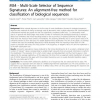678 search results - page 2 / 136 » On Complexity Measures for Biological Sequences |
BMCBI
2004
13 years 5 months ago
2004
Background: In a previous paper, we introduced MUSCLE, a new program for creating multiple alignments of protein sequences, giving a brief summary of the algorithm and showing MUS...
RECOMB
2003
Springer
14 years 5 months ago
2003
Springer
Many genomic sequences and, more generally, (multivariate) time series display tremendous variability. However, often it is reasonable to assume that the sequence is actually gene...
BIBM
2008
IEEE
14 years 2 days ago
2008
IEEE
Identifying functionally important sites from biological sequences, formulated as a biological sequence labeling problem, has broad applications ranging from rational drug design ...
BMCBI
2006
13 years 5 months ago
2006
Background: Existing biological databases support a variety of queries such as keyword or definition search. However, they do not provide any measure of relevance for the instance...
BMCBI
2010
13 years 5 months ago
2010
Background: While multiple alignment is the first step of usual classification schemes for biological sequences, alignment-free methods are being increasingly used as alternatives...

